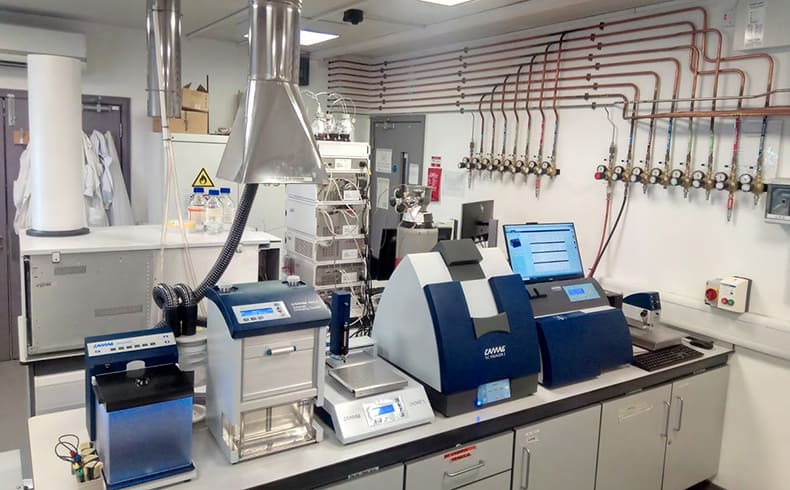In Enterprise Ireland’s Institutes of Technology Capital Call 2019, Shannon ABC were successfully awarded a HPTLC suite to the value of €105,000. This suite is the first of its kind in Ireland available for commercial and research projects, and can be used for a range of applications:
- Pharmaceutical – Quality Control; Content Uniformity Test; Identity and purity checks; stability tests
- Herbals – Identification; Stability tests; Detection of adulteration; Assay of marker compounds
- Clinical – Lipids; metabolism studies; drug screening; doping control
- Food and Feed – Quality Control; Analysis of additives e.g. vitamins; pesticides; stability tests
- Cosmetics – Identity of raw material; Analysis of preservatives, colouring materials etc; screening of illegal ingredients
- Biotechnology – Characterization of enzymes (product profiles); Proteomics (coupling HPTLC to Mass Spectrometry); Process development and optimization;
- Process monitoring – Cleaning validation,
- Environment – Water; soil; residue analysis
- Forensics – Molecule investigation; dyestuff analyses
What is Chromatography?
Chromatography is a scientific method used to separate different components in a mixture and to identify key compounds of interest present in the mixture. The process involves applying a very small sample of the mixture to a solid, porous layer (stationary phase) and passing a liquid solvent (mobile phase) through this stationary phase. The components in the sample will pass through the stationary phase at different rates, depending how much they like to stick to it or their preference to move with the mobile liquid phase.
Thin layer chromatography (TLC) uses a layer of silica poured onto a glass plate as a stationary phase. The mobile phase is placed in the bottom of a glass container and the glass plate, to which the test samples have been applied, is placed into this. As the mobile phase passes up through the glass plate, the compounds will adhere to the stationary phase at different rates leading to separation of components.
What is HPTLC?
High Performance Thin Layer Chromatography (HPTLC) gives much greater resolution and separation of components than normal TLC. It uses chromatographic stationary phases with excellent separation efficiency and employs state of the art instrumentation for all steps in the procedure. This includes precise sample application, standardized reproducible chromatogram development and software-controlled evaluation. HPTLC shows at a glance the similarities and differences between samples and references. Therefore, it can be used for analysis of raw materials & finished products, for the determination of purity (adulteration/fraud) and stability studies (shelf life). It can also be used for process development i.e. samples can be analysed at different stages of a process. By using reference standards, compounds can be quantified precisely.
HPTLC is a rapid cost-effective method in comparison to other separation methods and analysis of many samples in parallel takes typically less than an hour to run. Because the HPTLC plates are disposable, samples with biologically complex compounds (high matrix content) can be analysed. The equivalent samples in more sophisticated chromatography techniques (e.g. LCMS, HPLC and GCMS) would lead to column clogging. Considerably much less solvent is used for mobile phase in HPTLC as compared to other chromatography techniques making it more environmentally friendly and cost effective. As HPTLC has a non-destructive nature, analytes can be eluted after separation and identified using our existing equipment in laboratory e.g. Mass Spectrometry.
What does the equipment consist of?
The HPTLC suite is composed of a number of components.
- Sample Applicator – Application of sample to stationary phase i.e. TLC/HPTLC plate
- Development Chamber – Separation of components
- Derivatizer set and Plate heater – Derivatization: Chemical spraying of plate to detect compounds not visible under white/UV light
- Documentation System and TLC Scanner – Visualization/Evaluation of TLC/HPTLC plate
- Band cutting instrument which can be connected to existing Mass Spectrometers – MS Analysis (optional): Bands can be cut from TLC/HPTLC plate and identified on our existing Mass Spectrometers
- Software for operation of equipment and analysis – Qualitative and Quantitative Analysis of Results
If you would like more information on this system, and how it may be of help for your company, please contact Dr Catherine Collins, Business Development Scientist (Catherine.Collins@lit.ie) or Dr Tim Yeomans, Centre Manager (tim.yeomans@staff.ittralee.ie).
